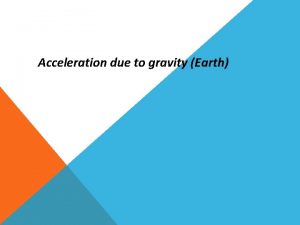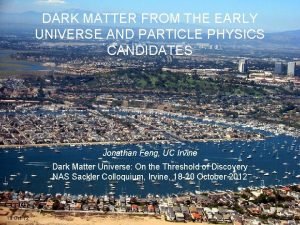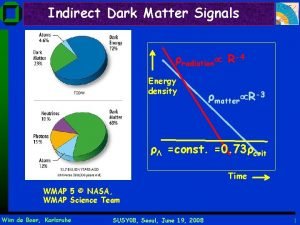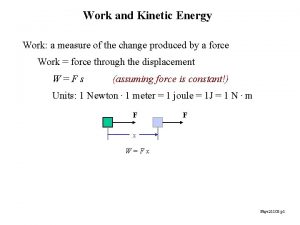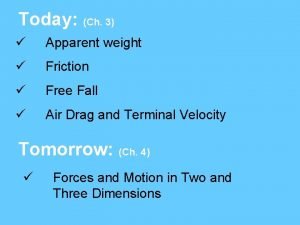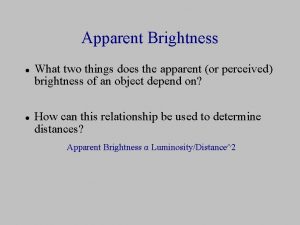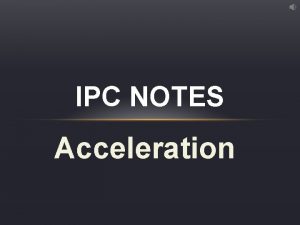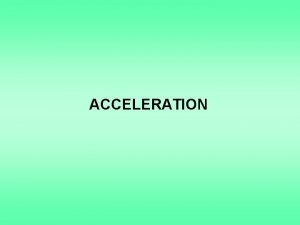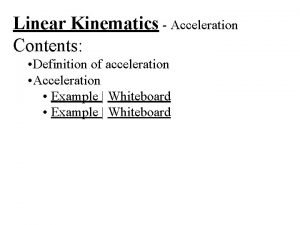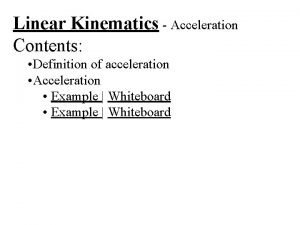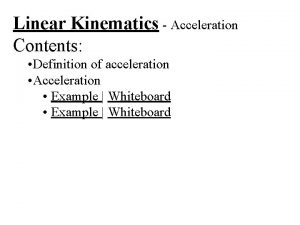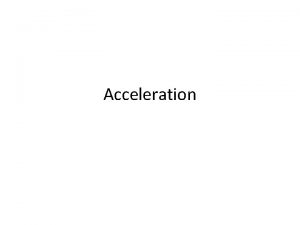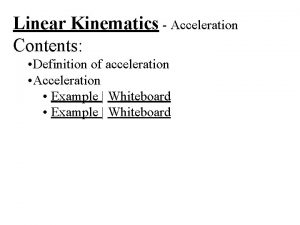Dark Energy or Apparent Acceleration Due to a





















- Slides: 21

Dark Energy or Apparent Acceleration Due to a Relativistic Cosmological Model More Complex than FLRW? Prof. Mustapha Ishak Cosmology and Relativity Group Department of Physics The University of Texas at Dallas Collaborators: J. Richardson, D. Garred, D. Wittington, A. Nwankwo, R. Sussman Ishak et al. Phys. Rev. D 78, 123531 (2008) Mustapha Ishak (U. T. Dallas) ar. Xiv: 0708. 2943 [astro-ph] 1

Cosmology & Relativity at University of Texas at Dallas Mustapha Ishak (U. T. Dallas) 2

Contributions to research on cosmic acceleration and related questions n " Probing Cosmic Acceleration Beyond the Equation of State: Distinguishing between Dark Energy and Modified Gravity Models" Mustapha Ishak, Amol Upadhye, David N. Spergel. Preprint available at astro-ph/0507184. Published in Physical Review D, 74, 043513 (2006). n “Remarks on the formulation of the cosmological constant/dark energy questions. ” n ""Probing decisive answers to dark energy questions from cosmic complementarity and lensing tomography" n "Dynamical dark energy: Current constraints and forecasts" n n Mustapha Ishak. Published in Foundations of Physics Journal, Volume 37, Number 10, (2007) 1470 -1498. Paper available at the Los Alamos Archive Server as astro-ph/0504416 Mustapha Ishak (2005). Published in Monthly Notices of the Royal Astronomical Society, V 363, issue 2, p 469 (2005). Paper available at astro-ph/0501594. Amol Upadhye, Mustapha Ishak, Paul J. Steinhardt (2004). Published in Physical Review D, 72, 063501 (2005). Preprint available at astro-ph/0411803. “The Contribution of the Cosmological Constant to the Relativistic Bending pf light Revisited. ” Wolfgang Rindler and Mustapha Ishak. Published in Physical Review D, 76, 043006 (2007). Paper available at the Los Alamos Archive Server as [astro-ph] ar. Xiv: 0709. 2948 “Light Deflection, Lensing, and Time Delays from Gravitational Potentials and Fermat's Principle in the Presence of a Cosmological Constant. ” Mustapha Ishak. Submitted to Physical Review D Journal (2008). Preprint available at the Los Alamos Archive Server as [astro-ph] ar. Xiv: 0801. 3514 “A New Independent Limit on the Cosmological Constant/Dark Energy from the Relativistic Bending of Light by Galaxies and Clusters of Galaxies”. Mustapha Ishak, Wolfgang Rindler, Jason Dossett, Jacob Moldenhauer, Chris Allison. Submitted to Monthly Notices of the Royal Astronomy Society (2008). Preprint available at the Los Alamos Archive Server as [astro-ph] ar. Xiv: 0710. 4726 “Dark Energy or Apparent Acceleration Due to a Relativistic Cosmological Model More Complex than FLRW? ” Mustapha Ishak, James Richardson, Delilah Whittington, David Garred. Physical Review D Journal (2007). Preprint available at the Los Alamos Archive Server as [astro-ph] ar. Xiv: 0708. 2943 Mustapha Ishak (U. T. Dallas) 3

Cosmic Acceleration and the Dark Side n Several possible explanations have been discussed in thousands of scientific publications: n A dark energy component/cosmological constant n A modification to general relativity at cosmological scales n Averaging and backreaction effects n Apparent acceleration due to the fact that we live in a relativistic cosmological model more complex than FLRW Mustapha Ishak (U. T. Dallas) 4

May General Relativity Be With You (Jedi Einstein) n n GR history is full of surprises: starting from the prediction of a non-static expanding universe which already encountered some resistance May the force be with you (Jedi Yoda) n n n Today: Dark Side times (Dark Energy, Dark Matter, Cosmological constant, Modified Gravity models…) Mustapha Ishak (U. T. Dallas) 5

Cosmic Acceleration and the Dark Side n Several possible explanations have been discussed in thousands of scientific publications: n A dark energy component/cosmological constant n A modification to general relativity at cosmological scales n Averaging and backreaction effects n Apparent acceleration due to the fact that we live in a relativistic cosmological model more complex than FLRW Mustapha Ishak (U. T. Dallas) 6

Do we have the right model in hands? n We can’t explain ~70% (or~95%) of the observed dynamics n Certainly, one should praise the achievements of the FLRW model, however, one should also allow himself/herself to ask and explore some necessary questions n Observations of the expansion rate of Supernovae can have different interpretations in FLRW versus an Inhomogeneous model n Do we live in a complex and subtle general relativistic cosmological model? n Is the FLRW model limiting our ability to interpret observations? n Well motivated questions in view of the non-linearity of GR, and the unsolved averaging problem in cosmology (see other talks) Mustapha Ishak (U. T. Dallas) 7

Apparent acceleration seen from an under-dense region n An apparent acceleration is possible if we live in an under-dense region of the universe n Apparent acceleration can result from the Hubble parameter, H 0, being larger inside the under-dense region than outside of that region n In FLRW, H(t) is a function of time only but in inhomogeneous models H(t, r) is a function of time and space n Supernova observations imply a larger H 0 at low redshifts then at higher redshifts n In FLRW models this implies acceleration while in inhomogeneous models different values of H are possible without acceleration Mustapha Ishak (U. T. Dallas) 8

Apparent acceleration using the Szekeres. Szafron inhomogeneous models n n Several interesting papers explored the question using the Lemaitre-Tolman-Bondi (LTB) models However, because of the spherical symmetry of LTB, the results can be viewed as a proof of concept unless we sacrifice the cosmological/Copernican principle (but see some recent discussions, e. g. Celerier et al, 06/2009) n It is desirable to explore the question of apparent acceleration using more general models than LTB n Derived by Szekeres (1975) with no-symmetries (no killing vector fields) with a dust source. Generalized to perfect fluids by Szafron (1977). Studied by a number of authors. n Regarded as good models to study our inhomogeneous universe (GFR Ellis; A. Krasinski) n Have a flexible geometrical structure that can fit cosmological constraints and observations at various scales Mustapha Ishak (U. T. Dallas) 9

The approach is consistent with the Copernican Principle n n It is perhaps worth clarifying that we are not proposing the Szekeres model as the true model of the universe but rather investigating the possibility of an apparent acceleration in an inhomogeneous universe In this scenario, apparent acceleration is due to the fact that we happen to live in one of the many under-dense regions of the universe. No need to be close to the center of the under-dense region. In fact, there is no exact definition of a center in these models since not spherically symmetric So this is not all that inconsistent with the Copernican Principle (or the cosmological principle) Mustapha Ishak (U. T. Dallas) 10

Apparent acceleration using the Szekeres. Szafron inhomogeneous models n n n The Szekeres metric in Krasinski & Hellaby coordinates Have several sub-cases We explored one of them but plan to look into the other cases as well hyperbolic (k(r)<0), parabolic (k(r)=0), and elliptic (k(r)>0) The function E(r, p, q) and the constant ε=0, +1, or -1 also define further sub-cases and mapping of various hypersurfaces. Mustapha Ishak (U. T. Dallas) 11

Observations in inhomogeneous models and the null geodesic equations n n n The null geodesic equations describe the motion of light rays arriving to us from astronomical objects It is necessary to solve these equations it in order to derive observable functions, such as the luminositydistance to supernovae This equation is easily solved in the FLRW but not in the Szekeres models, and here we employ an analytical and numerical approach to the problem Mustapha Ishak (U. T. Dallas) 12

Observations in inhomogeneous models and the null geodesic equations (not radial) Mustapha Ishak (U. T. Dallas) 13

Observations in inhomogeneous models and the null geodesic equations: numerical integration n We introduced the redshift in the equations The system can be regarded as a second order ODE system with the parameters given by the Einstein Field Equations Further, we used the Runge-Kutta method with the following vectors in order to separate the 4 second order ODEs to 8 first order ODEs Mustapha Ishak (U. T. Dallas) 14

Hubble diagram for the Szekeres models n The luminosity-distance is found numerically using n n It dependends on r, p, and q (or similarly on r, theta, and phi) Next, the magnitude is given by We used Supernova Combined Data Set as in Davis et al 2007, Wood-Vasey et al 2007, and Riess et al 2007. Mustapha Ishak (U. T. Dallas) 15

Results: Ishak et al. Phys. Rev. D 78, 123531 (2008) ar. Xiv: 0708. 2943 [astro-ph] n The data is 94 Supernova (up to $1+z=1. 449$) from Davis et al 2007, Wood-Vasey et al 2007, and Riess et al 2007 n The Szekeres model fits the data with a chi^2=112. This is close to the chi^2=105 of the LCDM concordance FLRW model. n n Because of the possible systematic uncertainties in the supernova data, it is not clear that the difference between the two chi^2 and fits is significant. And we did not explore all the Szekeres models The Szekeres model used is also consistent with the requirement of spatial flatness at CMB scales. Mustapha Ishak (U. T. Dallas) 16

Conclusions and future work n The Szekeres model fits current supernova data almost as well as the LCDM model and are also consistent with the spatial flatness required by the CMB n Approach can be consistent with the Copernican Principle n While the LCDM model requires a cosmological constant, the Szekeres inhomogeneous model does not n Although more work remains, our preliminary results encourage further investigation of the possibility of apparent acceleration using inhomogeneous models n Much more work needs to be done: We are exploring a list of items/issues in ongoing research n We plan to investigate comparisons of the Szekeres-Szafron models and possibly other inhomogeneous models with CMB and large-scale structure observables n In a more general context, we have plans to advance the comparisons between observations and inhomogeneous models Mustapha Ishak (U. T. Dallas) 17

In a golden era of cosmology, “We know a lot about our universe but we understand very little” Contents of the universe: Baryons: 4% Dark matter: 23% Dark energy: 73% Massive neutrinos: 0. 1% Spatial curvature: very close to 0 Mustapha Ishak (U. T. Dallas) 18

Cosmology & Relativity at University of Texas at Dallas Mustapha Ishak (U. T. Dallas) 19

This is how the Wilkinson Microwave Anisotropy Probe (WMAP) sees the CMB Mustapha Ishak (U. T. Dallas) 20

Contributions to research on cosmic acceleration and related questions n " Probing Cosmic Acceleration Beyond the Equation of State: Distinguishing between Dark Energy and Modified Gravity Models" Mustapha Ishak, Amol Upadhye, David N. Spergel. Preprint available at astro-ph/0507184. Published in Physical Review D, 74, 043513 (2006). n “Remarks on the formulation of the cosmological constant/dark energy questions. ” n ""Probing decisive answers to dark energy questions from cosmic complementarity and lensing tomography" n "Dynamical dark energy: Current constraints and forecasts" n n Mustapha Ishak. Published in Foundations of Physics Journal, Volume 37, Number 10, (2007) 1470 -1498. Paper available at the Los Alamos Archive Server as astro-ph/0504416 Mustapha Ishak (2005). Published in Monthly Notices of the Royal Astronomical Society, V 363, issue 2, p 469 (2005). Paper available at astro-ph/0501594. Amol Upadhye, Mustapha Ishak, Paul J. Steinhardt (2004). Published in Physical Review D, 72, 063501 (2005). Preprint available at astro-ph/0411803. “The Contribution of the Cosmological Constant to the Relativistic Bending pf light Revisited. ” Wolfgang Rindler and Mustapha Ishak. Published in Physical Review D, 76, 043006 (2007). Paper available at the Los Alamos Archive Server as [astro-ph] ar. Xiv: 0709. 2948 “Light Deflection, Lensing, and Time Delays from Gravitational Potentials and Fermat's Principle in the Presence of a Cosmological Constant. ” Mustapha Ishak. Submitted to Physical Review D Journal (2008). Preprint available at the Los Alamos Archive Server as [astro-ph] ar. Xiv: 0801. 3514 “A New Independent Limit on the Cosmological Constant/Dark Energy from the Relativistic Bending of Light by Galaxies and Clusters of Galaxies”. Mustapha Ishak, Wolfgang Rindler, Jason Dossett, Jacob Moldenhauer, Chris Allison. Submitted to Monthly Notices of the Royal Astronomy Society (2008). Preprint available at the Los Alamos Archive Server as [astro-ph] ar. Xiv: 0710. 4726 “Dark Energy or Apparent Acceleration Due to a Relativistic Cosmological Model More Complex than FLRW? ” Mustapha Ishak, James Richardson, Delilah Whittington, David Garred. Physical Review D Journal (2007). Preprint available at the Los Alamos Archive Server as [astro-ph] ar. Xiv: 0708. 2943 Mustapha Ishak (U. T. Dallas) 21
 Dark matter and dark energy presentation
Dark matter and dark energy presentation In a dark dark town
In a dark dark town Is radial acceleration the same as centripetal acceleration
Is radial acceleration the same as centripetal acceleration Relationship between angular and linear quantities
Relationship between angular and linear quantities Radial acceleration formula
Radial acceleration formula Linear acceleration vs tangential acceleration
Linear acceleration vs tangential acceleration Tangential acceleration and centripetal acceleration
Tangential acceleration and centripetal acceleration Acceleration due to gravity
Acceleration due to gravity Gravitational field strength equation
Gravitational field strength equation Quadrilatero con 2 lati paralleli
Quadrilatero con 2 lati paralleli Liberty chapter 20
Liberty chapter 20 Grande rhetra
Grande rhetra Due piccole sfere identiche sono sospese
Due piccole sfere identiche sono sospese Energy energy transfer and general energy analysis
Energy energy transfer and general energy analysis Energy energy transfer and general energy analysis
Energy energy transfer and general energy analysis Cube of stabilized dark energy
Cube of stabilized dark energy Dma dark energy
Dma dark energy Acceleration of
Acceleration of Rarefraction
Rarefraction Apparent weight
Apparent weight Contour of gingiva in gingivitis
Contour of gingiva in gingivitis Cause of refraction of light
Cause of refraction of light







